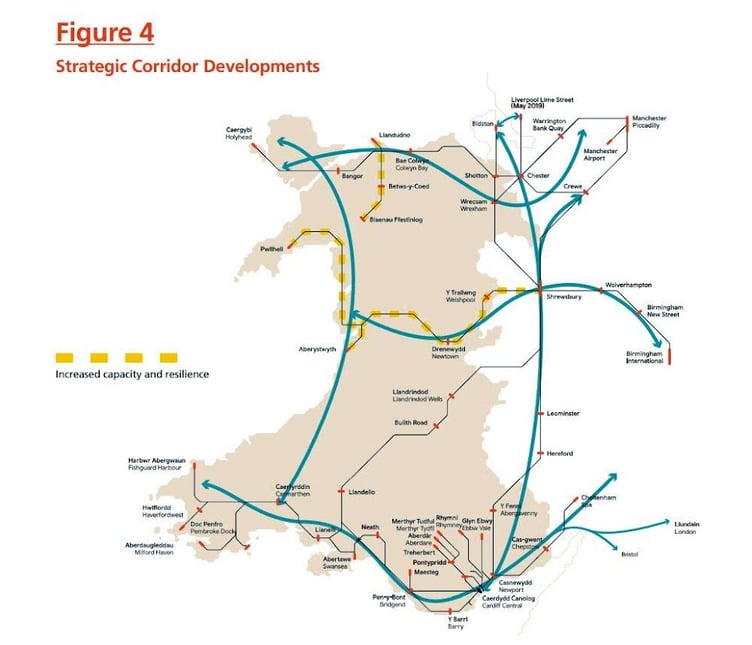How long will it take for North and South Wales to be united by a railway? The sad thing is such a line used to exist, and pressure is growing for the railway to re-open.
For nearly ten years Traws Link Cymru has been campaigning for the re-introduction of a number of railway lines across Wales including lines connecting Aberystwyth and Carmarthen, and Afon Wen and Bangor.
The group, which recently introduced its new chair, Professor Mike Walker, believe that the re-introduction of these lines could unlock the agricultural and tourism potential of mid and west Wales — areas it describes as “some of the most deprived areas of the United Kingdom and, indeed, Western Europe.”
The Aberystwyth to Carmarthen line has a long history. First built in 1860, the line connected Carmarthen and Conwil and was later extended to reach Llandysul and Newcastle Emlyn in the 1890s.
Following this, there was an ambitious attempt to connect Manchester, the industrial Midlands and Northwest England to the docks at Milford Haven. This line would pass through Strata Florida junction and run along the Carmarthen line before heading to Milford Haven.
The original plan for the line was to provide the cotton industry of Lancashire with an alternative port to Liverpool.
However, despite ambitions, this plan was never realised as costs spiralled due to the difficult terrain the line was forced to traverse.
Although the Manchester to Milford line was abandoned, Aberystwyth to Carmarthen functioned for nearly a century.
Mike Walker, Chairman of Traws Link Cymru said: “Aberystwyth to Carmarthen operated for close to 100 years, it was closed in 1965 with one line left running for a few further years to support creameries in the area with a daily milk train.”
The line was one of many to fall victim to the Beeching Cuts of the 1960’s, forcing the line to close and subsequently tracks were removed.
Today, where the line once lay, stands a number of houses alongside other infrastructure.
However, for those who still need to get to Carmarthen or Aberystwyth there is a long journey ahead. Aberystwyth to Carmarthen via train is a notorious trip, due to closures of the past; the Welsh rail network is left with some gaping holes, meaning that travel is only really supported from east to west.
Aberystwyth and Carmarthen are only some 40 miles apart however, via train, the journey can take upwards of six hours.
For comparison, here is a list of some other train journeys across the UK which can be completed in six hours or less:
::Birmingham → Norwich – 3 hours 52 minutes (163 miles)
::Manchester → Ipswich – 4 hours 30 minutes (232 miles)
::Exeter → Leeds – 4 hours 34 minutes (284 miles)
::Brighton → Newcastle – 4 hours 43 minutes (348 miles)
::Shrewsbury → Dundee – 5 hours 52 minutes (350 miles)
So why is it that a journey which is nearly nine times the distance can be completed in less time than Aberystwyth to Carmarthen?
If the train is your transport of choice between the two towns, expect scenic views as you detour out of Wales, across the English border into Shrewsbury and then back into Wales and over to your destination.
Walker told Cambrian News: “If you want to get from Aberystwyth to Carmarthen currently, you have to go all the way to England, because Wales is almost an off branch of the English rail network. The Cambrian lines were opened to connect industry towns, in West Wales. This was particularly used to connect creameries, such as that in Felinfach to English cities as far as London.”
The Welsh rail network has been described as a “branch” by more than Traws Link Cymru however.
Gareth Dennis, a railway engineer and writer is also one to express his concern regarding Welsh rail infrastructure, describing the system as a “mess.”
In a video posted on his YouTube channel, as part of his series Rail Natter in which Gareth and his guests discuss all things railways, Gareth explained: “There isn’t really a “Welsh” network at all, it is just a series of branches of the English one.”
He went on to say that, “this network, particularly in South Wales, is a railway network you might see in one of the various imperial coastal regions in the continent of Africa.
“These networks are designed for resource extraction, they are designed to take things in the ground and get them to harbours to send them elsewhere.
“The fact that this railway network was set up to strip resources and send them to England and the rest of the world as part of the broader imperial machine is partly why the network is so bad,” Gareth said.
The failures in Welsh rail infrastructure come largely from the system which is used to decide which areas are granted funding for rail developments.
Walker told the Cambrian News: “Benefit cost ratio (BCR) studies which have been conducted in the past have put the Aberystwyth to Carmarthen line at 0.43 BCR which makes it unviable; you need at least a BCR of 1.1 or 1.2 to make it a strategic and economic decision.
“However, we use the example of the boarder’s railway in Scotland, which is Edinburgh to Tweedbank,” he said.
The boarder’s railway is a line which is unlike lines across the rest of the country.
“The boarder’s railway in 2013 when the case was proposed had a BCR of 0.5, which is very similar to Aber to Carmarthen but what they did with the boarder’s railway, they said: “this is a rural area, it has special needs, there are special circumstances here which means it isn’t judged by the same sort of criteria which is purely economic.
“This new approach raised the line’s BCR to 1.3,” he said.
This approach to rural rail infrastructure has offered a myriad of benefits to areas along the border’s railway, Mike said:
“The benefits which have accrued to that area have been extraordinary. In terms of tourist enhancement, in terms of house building, small scale industrial development all the way along the line. So, what that line does is show in a very real way, exactly what benefits could accrue if the lines we are discussing are opened.”
This line however would require the backing of the Welsh government.
When asked it by the Cambrian News, a Welsh Government spokesperson said: “We identified the west coast line, including Aberystwyth to Carmarthen, as a key strategic corridor development in our response to the UKG’s Williams Rail Review.
“However this is a reserved matter, and ultimately it is the responsibility of the UK Government to invest and deliver projects such as the reinstatement of this rail line. We continue to press the UK Government for full rail devolution and a fair funding settlement.”
Despite attempts in the past to take control of Welsh railways, full rail devolution has not been achieved by the Welsh Government, meaning that funding decisions such are left to the Uk Department for Transport.
During a discussion in the House of Commons on 19 May, when asked what steps the Department for Transport were taking to connect more towns to the railway network, Wendy Morton MP said: “The Government is investing record levels in rail enhancement across England and Wales. The £500 million “restoring your railways fund” is currently supporting over 45 schemes to reconnect communities and reverse the Beeching cuts.
“Sir Peter Hendy’s Union Connectivity Review supported further improvements between Mid Wales and the Midlands and we’re obviously considering those recommendations very carefully,” she added.
However, despite considerations from both the Welsh Government and the Department for Transport, there is a lot of competition for funding across the whole of Wales making campaigns like this all the more difficult.
Traws Link Cymru is hopeful that their campaign will see improvements to rail infrastructure in Mid Wales, opening up opportunities to those living and working in the area.
Linking Bangor to Caernafon would be a game-changer
Back in 2020 MS Llyr Huws Gruffydd spoke of the “gaping hole” in Welsh rail infrastructure. When he said this, Mr Gruffydd was referring specifically to the lack of connection between Afon Wen and Bangor.
Afon Wen to Bangor makes up the other half of Traws Link Cymru’s campaigning. The line that connects the two areas opened in 1862 as a passenger train run initially by London and North West Railway and then later by London, Midland and Scottish Railway.
The line which connected with the Cambrian Line had two branches, one running from Caernarfon to Llanberis and the other from Penygroes to Nantlle.
Despite running for over 70 years, the Llanberis branch closed to passengers in 1930, offering summer excursions between 1932 and 1939, and again from 1946 until 1962. However, the line was yet another victim of the Beeching cuts, finally closing its doors in December 1964.
Services from Bangor to Caernarfon survived for over 100 years however, the section was eventually also closed in 1972. This was not the end of this line however; in 2011 a restoration of the line from Caernarfon to Porthmadog was completed.
Despite this restoration, Wales continues to face a lack of investment in rail infrastructure. Back in 2020, Llyr Huw Gruffydd said:
“The truth is that successive Labour Governments in both Cardiff and Westminster did nothing to devolve the powers we need to develop the infrastructure we deserve and, as a result, we see public transport in Wales fall further and further behind in terms of investment, expansion and modernisation.”
The recently unveiled “Elizabeth Line”, which was built in celebration of the Queen’s platinum jubilee, is reported to have cost £19 billion. However, in a report released by the Welsh Government in September 2020, it was stated: “The total UK Government rail enhancement “investment” in Wales, from 2001 to 2029 is of the order of £2.2Bn. This is a most generous interpretation and likely overstates the actual figure.”
Lack of investment from the UK Government has seen vast areas; such as that which encompasses Afon Wen, untouched by rail networks, leaving residents or visitors no other option than to employ other modes of transport.
Robert Saxby from Traws Link Cymru said: “The west coast of Wales is currently seen as very remote from the main centres of population such as London and Manchester. I overheard a visitor saying ‘I wanted to go to Harlech but I could have gone to the Alps quicker!”.
“Currently it takes over six hours by train from Pwllheli to London and over five hours to Manchester.
“Although it only takes 3h 15min by train from Bangor to London; the time needed to get to Bangor by bus from Pwllheli means that going to London that way still takes nearly six hours and is much less convenient.”
However, there may be some hope that this line is reopened.
“When I was working for Gwynedd County Council, British Rail asked me for visitor numbers to Caernarfon Castle,” said Bob.
“When I gave them the figures they said ‘if the line were still open we would be running it at a profit!’.”
“The success of the Borders Line in Scotland, which is similar in length to Bangor – Afon Wen, indicates that there might also now be a strong business case for the whole line, particularly with the changes in transport demand regarding commuting and leisure travel since covid,” he added





Comments
This article has no comments yet. Be the first to leave a comment.